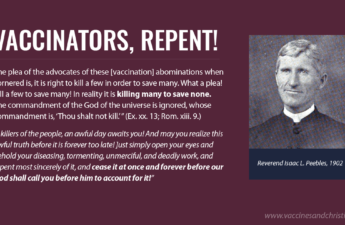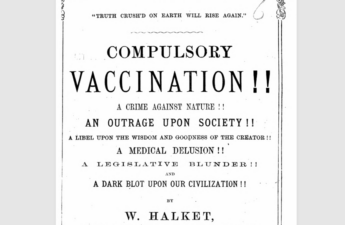
regularly tortured to make it appear thus? The
evidence throughout vaccine history
supports the latter.
by Stephen Halbrook
While many aren’t willing to admit it when it doesn’t suit their purpose, statistics can be easily manipulated — and are regularly done so to further one agenda or another. Entire books have been written on this subject. As one author notes,
There are several undeniable truths about statistics: First and foremost, they can be manipulated, massaged and misstated. …
Second, if bogus statistical information is repeated often enough, it eventually is considered to be true.[1]
And so,
It is a fact that facts are stubborn things, while statistics are generally more pliable … figures don’t lie, but liars figure. You can torture numbers and they will confess to anything. And statistics mean never having to say you are sorry.[2]
Indeed, it is quite easy to “produce” statistics behind closed doors, and then pass them on to the public as “facts”; all that it requires is trust on the public’s part. But beyond this, statistics can be incorrect even when produced sincerely. As economist Thomas Sowell writes,
In the real world … even without ideological bias or manipulation, statistics can be grossly misleading.[3]
This doesn’t mean that statistics are utterly useless; but we shouldn’t blindly embrace whatever statistics are put before us — especially when they defy biblical truths, common sense, and facts to the contrary, or when there is evidence of manipulation. Indeed, man is fallen and finite, and so he too often sets out to deceive — and even when he doesn’t, he too often misses the full picture.
And so, we ought not to think that vaccine statistics are immune to manipulation (especially since they are a highly profitable business). In fact, Dr. Archie Kalokerinos — who witnessed genocide of Australian Aborigines by vaccines by “safe and effective” vaccines — said:
[T]he further I looked into it the more shocked I became. I found that the whole vaccine business was indeed a gigantic hoax. Most doctors are convinced that they are useful, but if you look at the proper statistics and study the instance of these diseases you will realise that this is not so.[4]
Some testify to such statistical manipulation when it came to smallpox vaccines (which, we are told, eradicated smallpox). According to Dr. Russell of the Glasgow Hospital, “Patients entered as unvaccinated showed excellent marks (vaccination scars) when detained for convalescence.”[5] This could obviously influence statistics. Moreover, Lilly Loat, in The Truth About Vaccination and Immunization, writes:
In his Report for the year 1904 Dr. Chalmers, Glasgow M.O.H., stated that inquiries had been made of Registrars of Births in connection with smallpox cases entered as “unvaccinated” or “doubtful”; and 10 of the “unvaccinated” and 20 of the doubtful “were found to have been certified as having been successfully vaccinated in infancy.“[6]
Jno. Pickering, F.S.S., F.R.G.S., writes in the 1876 book The Statistics of the Medical Officers to the Leeds Small-Pox Hospital Exposed and Refuted,
I know very well that the statistics as to the cases and deaths of the vaccinated and unvaccinated are published for a purpose — a purpose that is unworthy and contemptible — it is simply to deceive the public mind, and to withdraw all consideration from the rationale of vaccination, … The Statistics of the Vaccinator are not to be trusted … The Vaccinator has a craze to support, and he will do it even at the sacrifice of truth.[7]
Pickering goes on to say:
My suspicions, as to the untrustworthiness of Medical Statistics, were first roused in March, 1872, but my enquiries were confined to the small-pox deaths. It never once occurred to me that, either from carelessness or audacity, the Medical Officers would include among the “unvaccinated,” living examples of the “successfully vaccinated.” During that month I investigated the particulars as to 16 deaths which had taken place in the Hospital between the 29th January and the 9th March, 1872. Of these 16 deaths the Medical Officers had returned 9 unvaccinated, 6 vaccinated, and 1 unknown. After a full and careful enquiry, which occupied Mr. Kenworthy and myself for several days, I attended before the Board of Guardians and handed in a return showing that the 16 deaths were composed of 12 vaccinated patients, 2 unvaccinated, and 2 unknown. The two unvaccinated were two out of the three cases “certified unfit,” being scrofulous from birth, and the two unknown were Irish vagrants, who had neither friend nor relative in the country who could give any account of them. Out of the 16 deaths there was, not one fair unvaccinated case. After all the trouble I took in this matter, neither the Board of Guardians nor the Medical Officers accepted my challenge to have a public enquiry.[8]
Dr. Charles Creighton (1847-1927) was a scholar, historian, and epidemiologist who initially supported vaccines. But after being asked to write an article on the topic for the Encyclopedia Britannica, he exhaustively studied the subject and found vaccination to be in error. On smallpox statistical manipulation, he writes in the said article:
The returns from special smallpox hospitals make out a very small death-rate (6 per cent.) among the vaccinated and a very large death-rate (40 to 60 per cent.) among the unvaccinated. The result is doubtful qua vaccination, for the reason that in pre-vaccination times the death-rate (18.8 per cent.) was almost the same as it is now in the vaccinated and unvaccinated together (18.5). At the Homerton Hospital from 1871 to 1878 there were admitted 793 cases in which “vaccination is stated to have been performed, but without any evidence of its performance”; the deaths in that important contingent were 216, or 27.2 per cent., but they are not permitted to swell the mortality among the “vaccinated.” Again, the explanatory remarks of the medical officer for Birkenhead in 1877 reveal to us the rather surprising fact that his column of “unvaccinated” contained, not only cases that were admittedly not vaccinated, but also those that were “without the faintest mark”; of the 72 cases in that column no fewer than 53 died. His column of “unknown” contained 80 per cent, of patients who protested that they had been vaccinated (28 deaths in 220 cases or 127 per cent.). Those who passed muster as veritably vaccinated were 233, of whom 12 died (51 per cent.). With reference to this question of the marks, it has to be said that cowpox scars may be temporary, that their “goodness “or “badness ” depends chiefly on the texture of the individual’s skin and the thickness or thinness of the original crust, and that the aspect of the scar, or even its total absence some years or even months after, may be altogether misleading as to the size and correctness in other respects of the vaccine vesicle, and of the degree of constitutional disturbance that attended it. This was candidly recognized by Ceely, and will not be seriously disputed by anyone who knows something of cowpox and of how it has been mitigated, and of the various ways in which the tissues of individuals may react to an inoculated infection. In confluent cases the marks on the arm would be less easily seen.[9]
Was smallpox ever conveniently diagnosed as other illnesses to make it appear that the smallpox vaccine was effective? According to George Bernard Shaw (1856-1950), yes.
During the last epidemic at the turn of the century, I was a member of the Health Committee of London Borough Council. I learned how the credit of vaccination is kept up statistically by diagnosing all the re-vaccinated cases (of smallpox) as pustular eczema, varioloid or what not — except smallpox.[10]
M. Beddow Bayly, M.R.C.S., L.R.C.P., in The Case Against Vaccination (1936), writes:
Between 1881 and 1924, in England and Wales, out of a total of 20,810 deaths only 5,508 were classified as unvaccinated, and these figures become more striking still when we realise that in deciding the diagnosis of the many “doubtful” cases it has been asserted by one Medical Officer after another that vaccination within ten years practically rules out the possibility of a case being smallpox, and the Ministry of Health itself has admitted that the vaccinal condition is a guiding factor in diagnosis….
Besides the admission of doctors themselves, one of the proofs of the dishonest “cooking” of official records is the attributing of an increasing number of deaths to chicken-pox; in the thirty years ending 1934, 3,112 people are stated to have died of chicken-pox, and only 579 of smallpox, in England and Wales. Yet all authorities are agreed that chicken-pox is a non-fatal disease; Sir William Osier (who himself contracted smallpox, although vaccinated several times) gave it as his opinion that such cases were probably “unrecognised smallpox,” and, he might have added, “in the vaccinated.” It was admitted before the Royal Commission that official doctors did not classify cases as vaccinated unless they could distinguish the marks, and that in severe cases the latter were frequently obscured by the eruption. Yet in spite of these and other sources of error which must be taken into account when examining any tables dividing cases into vaccinated and unvaccinated cases, in England and Wales at the present time the fatality among the vaccinated is over twice as great as among the unvaccinated, i.e., .51 per cent, compared with .21 per cent, for the years 1922-1933.[11]
We would, of course, expect statistical manipulation with something as deadly as the smallpox vaccine, which actually spread the very disease it was supposed to suppress.
Then there is Polio, which was clearly redefined after the release of the polio vaccine, making the vaccine look effective. Coincidence or corruption? You decide.
Of more recent history: Vision Launch makes a case that there was the suppression of the findings of CDC Epidemiologist Dr. Thomas Verstraeten linking vaccines and autism. Then, there is the confession of CDC Senior Epidemiologist William Thompson that findings linking Merck’s MMR vaccine to an explosion in autism among African American boys (under 3) were suppressed.[12] (The latter is discussed in the sobering documentary Vaxxed, which is waking up the world — including some doctors — to the dangers of vaccines.)
And of course, there is the ongoing problem of hiding the vaccine Holocaust via death certificates throughout vaccine history, which surely has a statistical effect.
Then there is the current measles hysteria. Measles was once recognized to be a benign illness, but now, to get everyone vaccinated with the MMR vaccine — and to push ongoing, mandatory vaccination for everyone — it is now considered deadly.
Perhaps we can go on and on (and I would like to expand more on this topic in the future); however, from what we have discussed, we should be thinking more critically when it comes to statistics — and know that not even vaccine statistics are immune from being erroneous or fraudulent.
If the tortured history of vaccine statistics proves anything, it is that vaccine statistics, the vaccine narrative, and vaccination itself cannot be trusted.
Notes
______________________________________
[1] Robert Rector, “Statistics can be manipulated to prove anything,” Pasadena Star-News/News (May 24, 2014). Retrieved April 7, 2016, from http://www.pasadenastarnews.com/general-news/20140524/statistics-can-be-manipulated-to-prove-anything.
[2] Rick Kirschner, Insider’s Guide to the Art of Persuasion: Use your Influence to Change Your World (Ashland, OR: Rick Kirschner, 2007), 134.
[3] Thomas Sowell, The Vision of the Anointed: Self-Congratulation as a Basis for Social Policy (Basic Books, New York, NY: 1995), 53.
[4] Archie Kalokerinos, “Interview,” International Vaccine Newsletter (June 1995). Retrieved September 16, 2016, from http://www.whale.to/v/kalokerinos.html.
[5] G. Miller, ed., To Doctor Alexander J. G. Marcet, London, 11 November 1801, Letters of Edward Jenner and Other Documents Concerning the Early History of Vaccination (London, England: The Johns Hopkins Press, 1983), xxxv. Cited in Neil Z. Miller, Vaccine Safety Manual For Concerned Families and Health Practitioners (Santa Fe, NM: New Atlantean Press, 2010, 2015), 32.
[6] Lilly Loat, The Truth About Vaccination and Immunization (1951). Retrieved April 22, 2016, from http://www.whale.to/a/stat2.html.
[7] Cited in Ibid.
[8] Cited in Ibid.
[9] Charles Creighton, “Vaccination,” in Encyclopaedia Britannica, 9th Edition (1888). Cited in 1902encyclopedia.com. Retrieved April 25, 2016, from http://www.1902encyclopedia.com/V/VAC/vaccination.html.
[10] G. Miller, ed., To Doctor Alexander J. G. Marcet, London, 11 November 1801, 64. Cited in Miller, Vaccine Safety Manual For Concerned Families and Health Practitioners, 32.
[11] M. Beddow Bayly, The Case Against Vaccination (1936). Retrieved May 2, 2016, from http://www.whale.to/vaccines/bayly.html.
[12] Speed The Shift, “The Conclusive Evidence Linking Vaccines and Autism,” VisionLaunch (February 8, 2016). Retrieved April 3, 2017, from http://visionlaunch.com/the-conclusive-evidence-linking-vaccines-and-autism/.
If you find this site helpful, please consider supporting our work.


